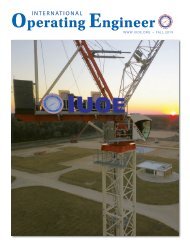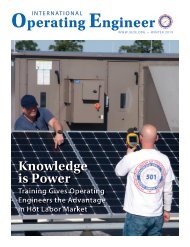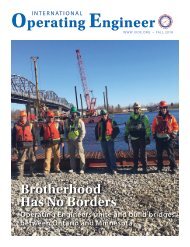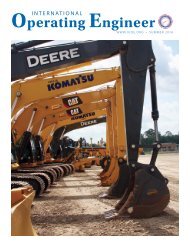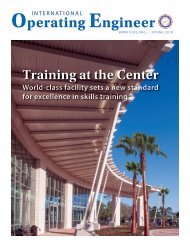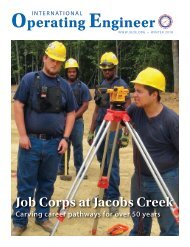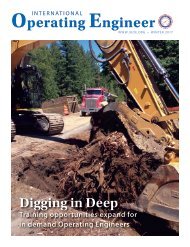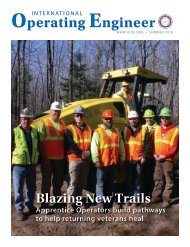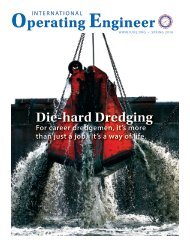125 Years Strong – An IUOE History
Celebrating the 125th Anniversary of the founding of the International Union of Operating Engineers
Celebrating the 125th Anniversary of the founding of the International Union of Operating Engineers
Create successful ePaper yourself
Turn your PDF publications into a flip-book with our unique Google optimized e-Paper software.
INTERNATIONAL UNION OF OPERATING ENGINEERS<br />
One of the gold dredgers, photographed in 1968 on the final day of its operation on a dredge pond in Yuba County, California, operated<br />
by members of I.U.O.E. Local No. 3 in San Francisco for the Wendell P. Hammon company. The operating engineers dredged over<br />
1-billion cubic yards of material during the 68 years Hammon’s company was in business, yielding more than $137 million in gold.<br />
several atomic facilities. Other significant<br />
Canadian projects at the forefront during that<br />
time and throughout the balance of the 1960s<br />
included a spectacular, $240-million job to<br />
successfully and economically extract oil from<br />
petroleum-rich sands along the Athabasca<br />
River in northern Alberta province.<br />
On the international political front, in May<br />
1967 the I.U.O.E. formed its Engineers<br />
Political Education Committee. The<br />
international’s own political arm, the committee<br />
was needed, as an article in that month’s<br />
International Operating Engineer explained,<br />
to “carry out the wishes of the members for<br />
supporting friends of labor.”<br />
To that end, “Make 1968 a Four-Star Political<br />
Year” was the theme proclaimed on the front<br />
cover of the February 1968 International<br />
Operating Engineer. General President Wharton<br />
would go on in 1969 to voice a call for “bold<br />
action” in 10 vital legislative areas, including<br />
on-the-job safety, cost-of-living, consumer<br />
welfare, social security, education and other<br />
measures relating to working people.<br />
The I.U.O.E. was making strong internal gains<br />
elsewhere, as well, and by its 28 th Convention<br />
in Bal Harbour, Florida, in April 1968, its<br />
membership had reached nearly 370,000, up<br />
from about 320,000 members just four years<br />
earlier in 1964. Also in September 1968, the<br />
union held its first-ever National Conference<br />
of Hoisting and Portable Engineers and made<br />
plans for a similar conference of stationary<br />
engineers soon after in Washington, D.C.<br />
As the decade was coming to a close,<br />
operating engineers were at work on almost all<br />
of the major construction projects underway<br />
in North America. Those included various<br />
new bridge projects undertaken in the wake of<br />
the December 15, 1967, collapse of the Silver<br />
Bridge over the Ohio River that resulted in the<br />
deaths of 46 people <strong>–</strong> and made the nation<br />
“bridge-safety conscious.”<br />
Arguably one of the most significant jobs on<br />
which I.U.O.E. members would ever work,<br />
construction of the World Trade Center in<br />
New York City and its 110-story “twin-tower”<br />
skyscrapers, had been underway since August<br />
1966. Work on the seven-building complex in<br />
Lower Manhattan would continue to utilize the<br />
skills of union operating engineers with Local<br />
No. 14 and Local No. 15 of New York City and<br />
other locals until completion in April 1973.<br />
Brother Gary G. Wetzel<br />
MEMBER, A VIETNAM VET, RECEIVED MEDAL OF HONOR<br />
Even after enemy fire downed<br />
the helicopter in which he was<br />
riding and then tore off his left<br />
arm on January 8, 1968, near<br />
Ap Dong <strong>An</strong> in South Vietnam<br />
during the Vietnam War, future<br />
I.U.O.E. Local No. 139, Wisconsin,<br />
Brother Gary G. Wetzel continued<br />
to fight. Despite his catastrophic<br />
injuries, the then-21-year-old U.S.<br />
Army private returned to his gun<br />
nest in the chopper and eliminated<br />
an enemy automatic-weapons<br />
position that was firing on his<br />
fellow soldiers.<br />
His act of courage and heroism<br />
earned Brother Wetzel, who was<br />
promoted to the rank of Specialist<br />
4, the Congressional Medal of<br />
Honor, which U.S. President<br />
Lyndon B. Johnson presented<br />
to him the following fall. Brother<br />
Wetzel, who joined his Wisconsinbased<br />
local in 1972, is the sole<br />
I.U.O.E. member to have received<br />
the nation’s highest military award.<br />
I.U.O.E. Local No. 139 Brother Gary G. Wetzel<br />
(Photo courtesy of Harley-Davidson Archives.)<br />
Future I.U.O.E. member U.S. Army Specialist-4 Gary G. Wetzel (far left) waits to receive the<br />
Congressional Medal of Honor from U.S. President Lyndon B. Johnson during a ceremony at the White<br />
House on November 19, 1968. (Executive Office of the President of the United States file photo.)<br />
Following the war that also left him with a prosthetic left arm,<br />
he learned how to operate heavy equipment in the early 1970s<br />
through a program offered by Local 139, equipment manufacturer<br />
J.I. Case Company and the State of Wisconsin. He was one of only<br />
15 men selected to participate in the course, which he completed<br />
as its second-most proficient operator.<br />
As a member of the I.U.O.E., he operated backhoes, loaders,<br />
telehandlers and other equipment using his artificial arm before<br />
retiring in 2013. He also served as a steward or general foreman<br />
on various projects for the local.<br />
Away from jobsites, Brother Wetzel annually rode his Harley-<br />
Davidson motorcycle in the Rolling Thunder parade on Memorial<br />
Day weekend in Washington, D.C., which calls for accountability of<br />
the nation’s POW/MIA soldiers. He also authored a book, “Jake,<br />
The Forgotten Warrior,” and writes poems, all of which are based<br />
on his experiences as a soldier.<br />
On July 7, 2017, Brother Wetzel helped dedicate a “transition<br />
wall” that marks the main entrance to the Gary G. Wetzel Way nature<br />
trail built in 2016 at Camp American Legion in Lake Tomahawk,<br />
Wisconsin. The wall memorializes all veterans, and the paved trail,<br />
constructed mainly by Local 139 apprentices who served in the<br />
military, provides a therapeutic nature walk for disabled veterans.<br />
LABOR OMNIA VINCIT<br />
WORK CONQUERS ALL



